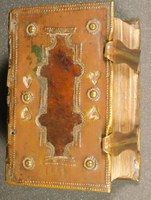Exhibit of the Month - March 2024
March 13 - April 9, 2024 Ante-room to the General reading Room (gate A), open Monday to Saturday 9 am - 7 pm (see opening hours of the NL)
Admission 20 CZK (free for the NL readers)
Dreyzehn romantische Ansichten von Töplitz, welche die schönsten und angenehmsten Gegenden von und um Töplitz vorstellen. Von Herrn Karl Postl gezeichnet, und Herrn A. Pucherna in Aetzmanier gestochen
Vienna ; Prague ; Karlsbad : František Haas, [1800-1808]
NL Prague, Sd 3353, purchased in a Prague antique shop in 2015
engraved title page (fol. 2a)
The grahic album features thirteen etchings with views of the North Bohemian spa town of Teplice and its surroundings. Apart from the Teplice Chateaux and town square, it also includes depictions of other nearby localities such as Duchcov, Krupka, Bohosudov, Bílina. All the vedute were created by the painter and drawer Karel Postl (1769-1818) and subsequently engraved by the engraver and graphic artist Antonín Pucherna (1776-1852). Both the artists specialized in pre-romantic and classicist landscape and urban scenes in the very beginning of the 19th century. The described album has a rich provenance history. The print originally belonged to the collection of the Jewish entrepreneur and collector Jindřich Waldes (1876-1941). In 1939, he was arrested by the Gestapo. After two-year imprisonment in concentration camps, he died in Cuba during his journey to New York, where he was awaited by his family who paid a high ransom for his release from Nazi captivity.
Explore here >>

Vienna: Johann Thomas von Trattner, 1786
NL Prague, 54 Se 357, purchased in a Prague antique shop in 2012
front board of the book
One of many editions of the famous hymnal, which in this particular copy contains nearly one thousand religious songs. The author, or rather editor, of this song book was Jiří Třanovský (1592-1637), an evangelical priest and exile after the Battle of White Mountain, a parish priest at St. Nicolas Church in the Lesser Town, Prague, in Holešov, Valašské Meziříčí and Liptovský Mikuláš. In his most famous literary work, he included many older songs that he knew from historical tradition in addition to his own song compositions. Třanovský´s Cithara was published for the first time in Levoča in 1636 and reached almost two hundred reprints by the 20th century. Each subsequent edition was enriched by new songs. Their number increased from the original four hundred to roughly one thousand one hundred. Cithara became an iconic book especially for Slovak evangelicals, as evidenced by the copy on display. On the front inside cover, endsheet and the verso of the title page, it contains handwritten notes of family nature in Slovak from around the mid-19th and the beginning of the 20th centuries. Brass fittings from 1869 decorate the front and back book board, protecting thus the book from damage. They testify to the personal relationship of the original owners to the book.
Explore here >>

Rostock : printing house of The Brethren of the Common Life, 28 July 1481
NL Prague 40 D 52, purchased in a Prague antique shop in 2016
incipit – the opening words of the main text (fol. 5a)
The set of Latin Sermons by the prominent theologian, church teacher and founder of the Order of Cistercians St. Bernard of Clairvaux (ca 1090-1153), which are thematically based on the Old Testament Song of Songs. It is a very precious late medieval incunable. The book was published in the period between Gutenberg´s invention of movable printing (1450) and the end of 1500. It bears specific features of this early typographic period, which include, for example, the arrangement of text and script imitating the appearance of manuscript originals, additional hand-made illuminations and incipit replacing a title page that did not yet exist. The interesting thing about this incunable is its provenance. The book was produced in the institutional printing house of a religious charity community (Bratři společného života-The Brethren of the Common Life-Brüder vom gemeinsamen Leben-Fratres vitae communis) in 1481, and not in one of the more common private commercial printing houses of the time. Even more interesting are the ownership inscriptions revealing that the copy on display was originally kept at the Klementinum and was part of the basic book foundation acquired by the Jesuits after their arrival in Prague in 1556.

Bechyně, between 1350 and 1400
NL Prague XII F 42, purchased from a private owner in 2014
fol. 181a with Latin and Czech text
It is a mixed parchment and paper manuscript that was created around the 2nd half of the 14th century in the Franciscan monastery in Bechyně. It contains over twenty originally separate Latin religious texts of pastoral nature, which belonged to individual monks at Bechyně and were used for pastoral and catechetical activities. These text units were later arranged and bound into a book volume. The additional redaction was probably carried out by the Franciscan monk and preacher Dětřich. His name is several times repeated in different parts of the manuscript. Until now, all that was known about him was that he donated a book to the Minorite convent in Český Krumlov. The purchased volume on display thus demonstrates Dětřich´s wider activity in the field of book culture. Dětřich included mainly theological tracts and sermons written in Latin into his manuscript. However, in some places, also Czech words and sentences appear in the form of e.g. scribal verses or ownership inscriptions.
Explore here >>














